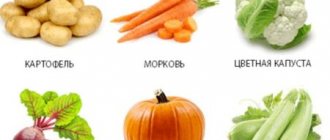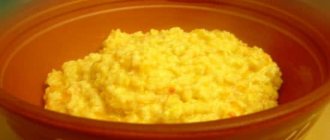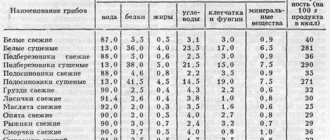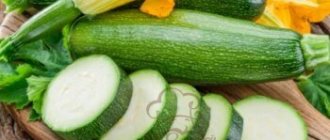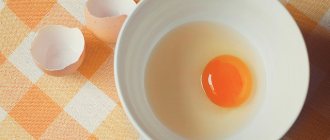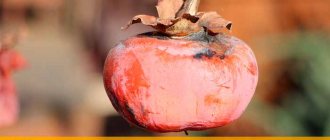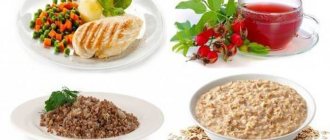Explosion hazards pea soup for pancreatitis. I advise you to read to the end!
We all know, honor and love pea soup, which at one time was one of the most common dishes in Soviet canteens! I'm not kidding, I actually really loved pea soup and still love it, but alas, I can no longer eat it due to pancreatitis.
Overall, this is absolutely delicious! But with pancreatitis, pea soup is a time bomb. I'll explain why.
Firstly, pea soup makes you terribly bloated. It makes a healthy person swell, but what can we say about those who have pancreatitis? That's horrible.
Well, everything is in order. First, I’ll explain why pea soup makes you swell.
Why does pea soup make you swell?
Pea soup with or without pancreatitis causes gas. Gases can enter our body in 3 ways:
1. Along with food;
2. Formed during the digestion process;
3. With the help of bacteria living in the colon.
Pea soup is a champion in the release of gases in the third category, even among a healthy population, not to mention pancreatitis! This happens because many of the nutrients in pea soup with pancreatitis are not completely digested and reach the bacteria of the large intestine.
First, you need to understand that peas, like beans, lentils, soybeans and other legumes, are seeds that are supposed to be planted and sprouts grow. Have you seen Koreans often selling sprout salads at markets? By the way, you can read a detailed recipe for making Korean sprout salad with photos here
You can eat legumes in this sprouted form for pancreatitis, but not in pea soup!
In general, I hope you understand, peas and all legumes are seeds that are planted. So these seeds contain a lot of protein, which is necessary to feed the seedling in the spring.
Spare proteins should be digested only in the spring, but not before! Therefore, legume seeds contain a large number of protease blockers (protease is an enzyme for digesting proteins). These blockers, combining with human digestive enzymes, block them, i.e. they are not allowed to work, so the protein is digested less well and some of the proteins reach the bacteria of the large intestine.
Decaying protein begins to release toxic gases: ammonia, methane, hydrogen sulfide - and poisonous monoamines. You can read about the digestion of protein in the body in the article about meat for pancreatitis.
In a word, much more gases are formed than usual!
Although protease blockers are found in the seeds of any plant, not just legumes, legume blockers are the most highly resistant. They do not collapse even after cooking or frying, unlike blockers of cereal grains and sunflower seeds (they are easily destroyed after heat treatment and do not cause heaving).
It seems that everything, the issue can be closed. I hope now you understand why pea soup makes you swell!
Now I’ll tell you a scary story about what happens when you eat pea soup with pancreatitis... Brrrr. Scary.
More details below!
Consequences of pancreatitis after pea soup.
One day Auntie Alya wanted to eat pea soup when she had pancreatitis. She read articles on the Internet that if you prepare pea soup correctly, you won’t get puffy after it, and she started preparing pea soup according to a special recipe.
The meaning of the recipe was that you need to soak the peas in water overnight, drain this water in the morning and cook the peas in this water over low heat until tender. Then simply add to the pan with the finished soup. There will be no puffiness, as promised on the Internet! And figurines.
It went so far that dear mother! Out of fear, Alevtina immediately sat down to write an article on a blog about pancreatitis, so that God forbid this happens to any pancreatic patient!
It's good that this scary story has a good ending!
After this pea soup for pancreatitis, I still had heartburn for 2-3 days. The stool was restored quickly within the next 1 day, and that was thanks to my constant treatment.
In general, all the signs of exacerbation of pancreatitis are abdominal pain (especially at night!), bloating, rumbling, heartburn, specific diarrhea. I'm serious!
I remember once, I also cooked pea soup as usual - the peas went straight into the soup, it was the same. What I mean is that it seems to me that no matter how you cook pea soup, pancreatitis will still cause you to swell.
Oh, think before you eat pea soup for pancreatitis, oh think. Better yet, don’t even think about it and don’t eat! This is completely serious!
It is better to prepare borscht according to my special recipe for pancreatitis or other light vegetable and dietary soups.
Well, the topic of our article today has exhausted itself. Good health to everyone and bye!
- Can you eat nuts if you have pancreatitis?
- Is it okay to have sausage if you have pancreatitis?
- Is it possible to drink kefir if you have pancreatitis?
- Is it possible to use bran for pancreatitis?
If you think that the article is really interesting and useful, then I will be very grateful if you share this information with your friends on social networks. To do this, simply click on the social media buttons.
Soups for pancreatitis have a therapeutic effect, help reduce the pain threshold and the inflammatory process in the pancreas. The value of first courses is that they include a large amount of microelements and vitamins, help remove toxins and normalize the functioning of the digestive system. Nutritionists recommend including different soups in your diet, choosing the components of the dish based on taste and preferences, with the condition that all the ingredients used to prepare the healthy dish are included in the list of permitted foods.
Patients with pancreatitis need to include soups in their daily menu. In case of exacerbation of the disease, they should be consumed several times during the day.
Peas and pea soup for pancreatic inflammation
With different forms and stages of development of inflammation of the pancreas, peas, pea soup and soup with pancreatitis can have varying degrees of effect on the organ.
For acute pancreatitis
Neither peas for pancreatitis nor dishes prepared on their basis are recommended for consumption during the treatment of the acute form of the disease. The product seriously burdens the stomach and interferes with normal digestion. In case of acute pancreatitis, the introduction of peas into the diet can cause the following negative consequences:
- diarrhea, stool disorder;
- flatulence, painful bloating;
- removal of useful minerals from the body;
- colic.
Thus, peas and pea soup in the diet for acute pancreatitis can significantly worsen the situation and slow down the healing process.
For chronic pancreatitis
For patients suffering from a chronic form of pancreatitis, during exacerbation, eating pea dishes is also undesirable. However, they can be introduced into the diet with caution during the recovery stage of the body. To ensure that the product does not cause negative consequences, it is important to use the following recommendations:
- Before cooking, peas must be soaked for several hours;
- the product must be washed thoroughly before use;
- you should boil the peas in the soup as best as possible;
- To reduce the negative effect on the pancreas, it is recommended to add dill to the dish.
Thus, with chronic pancreatitis, you can eat pea soup, but only at the stage of remission and in compliance with the specified rules.
What soups can you eat if you have pancreatitis?
When preparing soups, it is necessary to use products that can be consumed for pancreatitis. Nutritionists advise that first courses include ingredients whose action is aimed at normalizing the functioning of the pancreas.
For pancreatitis, it is allowed to consume soups with meat and fish, provided that the meat soup is prepared in secondary broth (the meat is boiled twice, draining the first broth). When choosing meat, preference should be given to low-fat varieties that do not contain a layer of fat. The meat should be cut very finely, so it will be better digested. Using fatty meat broth may aggravate the disease. According to nutritionists, rabbit, turkey, chicken and veal meat are best suited for making healing soups. To prepare fish soup, it is recommended to use pollock and hake.
Vegetable soups are very healthy. The use of soups made from potatoes, onions, carrots, zucchini, and pumpkin has a positive effect on health. You can season soups with salt, turmeric, herbs, and garlic. The use of soups made from fresh cabbage and millet is not recommended, since these products cause increased production of hydrochloric acid and can cause nausea and vomiting.
If you have pathology of the pancreas, you can also include milk soups in your diet with some restrictions. It is not allowed to prepare soup with undiluted milk, as the product can cause bloating, vomiting and provoke an attack of pancreatitis. It is recommended to prepare the soup with milk diluted with water (1:1); milk soups should be consumed no more than twice a week.
The benefits and harms of peas
How good are peas for pancreatitis? Of course, the composition contains vegetable protein, which is necessary for the restoration of the pancreas. Pea tissues contain a lot of potassium, magnesium and selenium, which have a strong anti-cancer effect. The vegetable is high in calories and exhibits a pronounced energy value, which means that the patient will eat little, being sufficiently full. The abundance of pea varieties helps you make an informed choice depending on taste and chemical composition.
Unfortunately, the matter is complicated by the composition. Peas contain fiber, a rough plant substance that is difficult to digest. The substance causes the pancreas to tense up, causing the formation of gases in the body, leading to a worsening of the condition and the development of an acute attack of pancreatitis. This is followed by diarrhea and severe abdominal pain.
Vegetarian soups for pancreatitis - recipes
Vegetarian soups for pancreatitis have a healing effect on the pancreas. Such soups have a large volume and low calorie content, have a positive effect on the digestive system, cleanse the body, normalize metabolic processes, and are excellent sources of vitamins and microelements.
Such soups should be prepared without salt or with a very small amount of it. You can diversify your dishes and give them an appetizing taste and appearance using spices and herbs. Adding carrots, curry, turmeric can improve the taste of the soup, as well as add brightness and a beautiful look to lunch. Vegetarian soups can be decorated with fresh herbs: parsley, dill, basil, cilantro, green onions - and as a result you get a very aromatic and appetizing dish.
Borsch
Borscht is a very common dish; many people love and cook it often. Patients with pancreatitis should prepare this dish following a special recipe.
For the base of the soup, use a broth of 1 carrot and 2 potatoes, then add half a beet. When cooking, you need to completely avoid overcooking. You can add greens to the finished dish.
Rice soup
This soup is suitable for consumption during an exacerbation of the disease. You need to take water - 600 ml, ¼ cup of rice, 1 potato, ¼ carrot. Salt, herbs, and sour cream can be added during the period of remission.
Vegetables are peeled, washed, carrots are grated, potatoes are cut into small cubes. The water is brought to a boil and pre-washed rice and chopped vegetables are added to it. After boiling, leave the soup on low heat for 15 minutes until the potatoes and rice are cooked. Before use, it is recommended to mash the potatoes with a fork or grind the soup in a blender.
Oatmeal soup
Made from Hercules oat flakes. Add a few tablespoons of oatmeal to 1.3 liters of water and cook over low heat. The resulting mass is filtered through a sieve and put back on the fire until it boils. You can add greens and some crackers to the soup.
Pearl barley soup
40 g of pearl barley are placed in 2 liters of water and boiled for 3 hours over low heat. The finished liquid is filtered and a vegetable soup is prepared using the resulting broth, choosing ingredients to taste. All vegetables should be finely chopped or shredded.
You can also pour a decoction of pearl barley into a plate, add a little salt and dip white bread croutons (not store-bought) into it.
Why are peas considered a healthy dish?
Despite the high calorie content, peas contain many vitamins and microelements that are simply necessary for the normal functioning of any healthy organism. These include vitamins PP, B, A, as well as microelements such as magnesium, sodium, calcium, chlorine, iron and some others. This product also contains nicotinic acid. This element helps control appetite, reduces the risk of cancer, and regulates cholesterol levels in the blood.
Diet soups
Dietary soups can only be prepared boiled or steamed. This diet involves multiple meals, up to 5-6 times a day, in small portions. To make food tasty and varied, dietary recipes have been developed.
Cauliflower puree soup
You need to take 200 g of cauliflower, 2 carrots and 3 potatoes. Peeled and chopped vegetables are poured with the same proportion of water and milk, after which the vegetables are boiled in this composition. When the broth is ready, beat all the vegetables with a blender, add a little salt, and add pre-grated hard cheese. The soup is put back on the fire for 5 minutes.
Summer soup
Peeled and cut into cubes 4 potatoes are poured with cold water and placed on low heat until boiling, then chopped carrots and onions are added to the broth. Finely chopped cucumbers, tomatoes, herbs and bell peppers are mixed in advance and added to boiling vegetables, salted (you need to add a pinch of salt) and cooked for another 5 - 10 minutes. Boiled rice can be served as a side dish for the soup.
Diet beef soup
The beef is washed, cut into small pieces, poured with cold water and put on fire. The resulting broth is drained, and the boiled meat is minced twice with a meat grinder.
Add pureed meat to the pre-prepared vegetable broth (potatoes, carrots, cauliflower, parsley, celery) and place on low heat for 10-15 minutes.
Diet chicken soup
The cleaned chicken carcass is boiled twice. The first broth is drained, after which the meat is washed and set to cook again. The repeated broth must be boiled, add a little salt and herbs. You can add rice, vermicelli and vegetables to the broth to taste.
Soup – puree of dried dried apricots and dried apples
You need to take dried apricots and dried apples in equal quantities, rinse well and cut into pieces. The crushed products should be filled with cold water and simmered over low heat for 30 minutes. After the broth, you need to filter, rub the apples and dried apricots thoroughly through a sieve, add sugar and cinnamon, and boil everything together again to a boil in the fruit broth. The finished composition must be cooled and diluted starch, in a small part of the broth, added to it. The resulting mixture should be added to the cooled mass, mixed, and brought to a boil.
Fish soup recipe
For pancreatitis, eating fish soup – puree – is beneficial. The dish turns out very tasty and satisfying. The soup contains a lot of useful substances and helps to replenish the body’s lack of vitamins when following a special diet.
To prepare the soup you need to take 0.5 kg of fish (pike or hake), 75 g of milk, 2 tbsp. l. flour, 3 tbsp. l. butter, herbs to taste (parsley, dill), one small onion, 2 potatoes and salt.
The fish is separated from the bones, the resulting fillet is poured with water and boiled, after boiling, removing the resulting foam and fat. Finely chopped potatoes, stewed onions, herbs and salt are added to the broth. The resulting composition is ground in a blender and seasoned with a sauce made from milk and flour. After the puree soup, put it on low heat again for 3 minutes.
Chicken soup
Chicken soup is consumed when remission occurs. Do not use young chicken. The soup is best prepared from adult chicken, which contains a large amount of active substances.
The bird is washed, simmered over low heat for 30 minutes, then the broth is drained, the meat is washed and a secondary broth is prepared. The broth is lightly salted, greens, finely chopped potatoes, and vermicelli are added. You can serve the soup with a spoonful of sour cream.
Cheese soups
Cheese is not recommended for consumption during an exacerbation of pancreatitis. When remission occurs, the dairy product can be introduced into the diet in small portions. Experts favor the use of Japanese tofu, which resembles cottage cheese.
Cheese soup with pumpkin
To prepare this cheese soup, you need to use recycled chicken broth as a base.
200 g pumpkin, 2 carrots, 200 g cauliflower, cut into small pieces and boil. After the vegetables have softened, they are crushed in a blender and mixed with the broth. The resulting mass is salted, mashed Japanese tofu is added and simmered over low heat for about 3 minutes. You can serve the puree soup with homemade croutons.
Cheese soup with vegetable broth
You need to take 1 carrot, medium-sized onion, and potato. Vegetables are cooked until tender, chopped in a blender and the resulting mass is mixed with the broth. You can add cheese and sour cream to the soup. You can decorate the dish with boiled shrimp.
Slimy soups
Mucus soup has a gentle effect on the walls of the stomach and intestines, and on the pancreas. Such soups are useful for diseases of the stomach and intestinal tract, in the postoperative period.
Slimy rice soup
The soup is prepared using 150 ml broth, 300 ml water, 40 g rice and 5 g butter. The rice is washed, left in boiled water for 15 minutes, then boiled for 1 hour. After time, the rice water is filtered through a fine sieve and added to the broth. The resulting soup is brought to a boil and served with pieces of chicken meat.
Oatmeal slimy soup
In order to prepare one serving of oatmeal soup, you need to take 200 ml of milk, 40 g of oatmeal, 10 g of fresh butter, ½ egg yolk, ½ teaspoon of sugar, 200 ml of water. Place a pan of clean water on the fire and bring to a boil.
Afterwards, oatmeal is added there and brought to a boil again for an hour. The cereal broth is filtered through a sieve, without wiping the strained off residue, and poured into a saucepan, bringing to a boil.
Prepare a mixture of milk and half the yolk, mix thoroughly, and carefully add to the finished soup. Add sugar and a pinch of salt to the soup.
Slimy rolled oats soup
To prepare one serving of soup, you need to take 40 g of rolled oats flakes, 350 ml of water, 100 ml of milk, 1 yolk, 10 g of butter, salt, sugar.
The flakes are poured into boiling water, cooked over low heat for about an hour, and filtered. An egg-milk mixture is pre-prepared from hot milk and egg yolk, the resulting mixture is added to the mucous broth, salted, butter and sugar are added.
Contraindications
To prepare dietary soups for pancreatitis, certain restrictions must be taken into account. The first broth when preparing soups is always drained. For soups, clean fillet is chosen; tendons and cartilage are not used.
It is forbidden to add irritating ingredients to soups, as well as foods that are not allowed for inflammation of the pancreas. The use of products that cause increased secretion of gastric juice, as well as fatty meats, is not allowed.
For pancreatitis, the use of radishes, sorrel, radish, pepper, lettuce, garlic, and rhubarb is contraindicated. Some vegetables should be consumed in limited quantities. Such vegetables include asparagus, white cabbage, tomatoes, cucumbers, and eggplants.
Soups for pancreatitis are an excellent way to diversify your diet without harm to your health. The first dishes, prepared according to the instructions of nutritionists, have a positive effect on the body and help quickly overcome the exacerbation of the disease.
Reviews
Dear readers, your opinion is very important to us - so we will be glad if you share your soup recipes for pancreatitis in the comments. This will also be useful to other users.
My husband has chronic pancreatitis. I cook for him separately, according to special recipes. First courses are especially good, allowing you to quickly overcome the acute period of the disease.
Using permitted products, I prepare various tasty and appetizing soups based on vegetables and dietary meats. The slimy soup made from rolled oats helps my husband. Even during an acute period, such soup is easily digested, and after it the pain decreases.
Pea soup and features of its preparation
In the material, we found out that in case of pancreatitis, the consumption of peas and all dishes derived from this vegetable is strictly contraindicated. For chronic pancreatitis, this product is also not recommended for use, especially if, after taking it, a deterioration in the patient’s condition is detected. If a negative reaction is not detected, then you can eat pea soup, but first you need to prepare the dish correctly.
Before you start preparing a dish, it is important to carry out the initial steps:
- Pre-soak the peas to soften them. It is important to use only cold water for soaking, since it will quickly ferment in warm water.
- Achieve complete boiling, thereby destroying the fiber.
- After preparing the dish, you need to add dill to it. Dill reduces the likelihood of negative reactions when eating peas.
Video
Peas are quite a popular product; they are actively used in all cuisines of the world. It can be a side dish, an addition to salads or a main course. They like to eat peas fresh, canned, pickled, and added to soups.
Legumes have a high nutritional value and a mild and pleasant taste.
Is it possible to have pea soup for pancreatitis? Not all patients are allowed to consume peas; with pancreatitis, the product can cause harm and aggravate the inflammatory process.
For this reason, when creating a diet, it is important to consult a doctor and include peas in your diet only after permission.
Acute pancreatitis
In the acute course of the inflammatory process, significant inhibition of the pancreas is observed; in severe cases, the patient faces necrosis of individual tissues. During this period, the organ is not able to produce the required amount of enzymes for normal digestion of food.
Like other varieties of legumes, peas for acute pancreatitis are classified as prohibited foods; they contain a lot of fiber, the substance cannot be absorbed by a weakened body and is excreted in its original form. But consuming fiber in the absence of disease, on the contrary, improves metabolic processes and digestion.
When the disease is at an acute stage, eating peas will clog the stomach, increase the negative symptoms of the disease, worsen your health, and cause bouts of diarrhea and vomiting. Consequently, dishes with peas and pea soup are prohibited for consumption in acute pancreatitis.
If a patient ignores the nutritionist’s instructions and the rules for eating peas, he will soon develop the following symptoms:
- flatulence;
- periodic painful colic;
- diarrhea.
Diarrhea is especially dangerous; it can cause rapid leaching of all important minerals from the body and dehydration.
An exception would be the consumption of peas and legumes at the final stage of treatment, when the manifestations of the disease began to subside. But even now the strictest precautions must be observed.
Peas and pancreatitis
Many nutritionists note the usefulness of this herbal product for pancreatitis and advise including it in the menu for this disease. However, it is strongly emphasized that in case of exacerbation of the acute or chronic form, peas and dishes made from them should not be consumed. Otherwise, even a small portion, such as soup, can provoke various complications.
If the doctor allows you to eat peas, you must adhere to the following rules:
- Eat dishes with peas separately, without mixing them with other foods.
- Comply with the daily drinking norm.
- Try not to overeat.
- Control the appearance of edema.
It is worth emphasizing that canned peas are much more nutritious than dried and fresh ones. It is even present in diet No. 5, which is recommended for acute and chronic manifestations of pathology, but again, canned peas should be eaten in moderation.
In acute illness
So, is it possible to eat pea soup for acute pancreatitis? According to doctors, this dish is not the best solution. The fact is that the protein in peas, as mentioned above, complicates the functioning of the gastrointestinal tract and glands, and also provokes other negative phenomena:
- Excessive diarrhea, provoked by a more active digestion process and a complication of already existing diarrhea.
- Bloating, which is observed in case of inadequate digestion of peas.
- Persistent and prolonged heartburn.
- Severe flatulence.
- Increased nausea.
- Excessive cleansing of the body, when even the substances it needs are removed from the body.
- Intense intestinal colic.
As you can see, peas can cause a relapse of pancreatitis, thereby worsening the patient’s condition. Therefore, pea soup and acute pancreatitis are absolutely incompatible things.
Chronic course of the disease
Many patients ask whether it is possible to have pea soup for pancreatitis when the disease is in stable and long-term dormancy? In this case, we can say the following: if a person feels well and does not exhibit negative symptoms, then the doctor may allow its use.
In order to check how loyally the gastrointestinal tract will accept pea soup, it is not necessary to cook it. It is better to check using other dishes in which this legume is present. For example, prepare vegetable puree from pumpkin, cauliflower, carrots and green peas. You can also go another way, for example, boil the peas, puree them and add them to already prepared vegetable soup.
If the gastrointestinal tract accepts such food without problems, and no negative consequences arise, you can try making soup. Pea soup for the pancreas should be cooked in accordance with the following instructions:
- Peas must be pre-soaked.
- Cook until completely boiled.
- You must add dill to pea soup.
If these points are carefully followed, the negative impact of peas on the entire digestive system is significantly reduced.
When the acute manifestation of the disease has decreased and a stable decline of symptoms is noted, and the patient’s well-being has improved, you can introduce young fresh peas into the menu, which do not need to be chopped, but must be soaked. In this case, use exclusively cold water, but not warm water, which can speed up the fermentation time.
These peas are added to a variety of salads, vinaigrettes and side dishes. Alternatively, it can be served stewed and baked, and you can also prepare puddings, casseroles and other similar dishes from it. It is used as a filling for rolls and pies, but make sure that the baking ingredients do not contain any products that are contraindicated for pathology.
In case of chronic disease
As is known, chronic pancreatitis is characterized by alternating acute periods of the disease and persistent or relative remission. When the pathological condition worsens, the pancreas is not able to cope with the assigned tasks normally and does not produce the required volume of pancreatic enzymes.
During an exacerbation, as in the acute phase of pancreatitis, eating peas and dishes with them is strictly not recommended. It is permissible to include the product in the diet only after inflammation has subsided, when remission occurs.
But even during remission, peas are eaten in small quantities, otherwise there will be an excess of fiber, the exacerbation will resume, and the characteristic signs of the disease will begin.
The optimal serving size for an adult patient is a maximum of 100-150 grams.
Is it permissible to eat peas if you have pancreatitis?
Those people who are sick with inflammation of the pancreas know that the disease occurs in 2 phases - a remission phase and an exacerbation phase. So, when it comes to the exacerbation phase, eating peas is strictly prohibited. Even though this product itself is quite light and is of plant origin, its shell contains rough substances that the inflamed pancreas will not be able to handle.
Peas can be included in food only when a period of remission occurs. But in addition to the remission itself, it is necessary to take into account the fact that the patient must have an adequate reaction of the body to this food product.
Attention! some doctors are against patients with pancreatitis eating peas, however, now this ban is most often lifted, only doctors warn that it is best to soak peas for several hours before cooking, and it is better to cook them in a pressure cooker, so they will become as soft as possible and not so difficult to digest.
As for the dose of green peas, it should not exceed 100g per day. This is explained by the fact that this legume contains only 20% protein, and the rest is carbohydrates. In addition, this product contains a lot of fiber. This is a useful element, but not for those people whose pancreas is inflamed. Due to the fiber in its composition, it is very difficult to digest.
Today, on the shelves of almost any store or supermarket you can find canned green peas in tin packages. The question arises, is it possible for sick people to eat these peas? For pancreatitis, peas in this form are categorically contraindicated, since when such a product is canned, many chemical elements are added to it, which are not at all beneficial for the patient’s body. It is not allowed to eat home-canned peas, since even when the product is pickled at home, vinegar and other spices are added to it, which the patient does not want to consume.
How best to use
For all patients with pancreatitis and cholecystitis, and other similar disorders, a number of rules have been developed; they regulate the methods of pre-processing peas, the rules of preparation, and consumption.
Begin preparing pea dishes by soaking the product in hot water, the minimum soaking time is 3-4 hours. After that, the grains are thoroughly washed under running water and soaked again, adding a little baking soda.
When preparing pea soup, the product should be completely boiled, thus reducing the load on the digestive organs. It is allowed to eat food only in the first half of the day, so that it has time to be well digested before bedtime. If you eat soup in the evening, the load on the body increases and unwanted reactions are possible.
Another recommendation is to eat legumes separately from other foods; any combination can have a bad effect on the condition of the pancreas. A large amount of fiber will provoke increased thirst, so it is important:
- be sure to follow the drinking regime;
- check yourself for edema;
- avoid overeating.
If the soup is difficult to digest, then green peas for pancreatitis are much easier to tolerate, but subject to reasonable consumption.
Porridge and pea puree, and other similar dishes are eaten warm, this helps the pancreas cope with the load faster. Foods that are too hot or cold take a long time to digest and are poorly absorbed.
Other pea dishes
At the stage of recovery after an exacerbation of the disease, you can simply introduce young green peas into the diet for pancreatitis. If the product is quite soft and tender, it is not necessary to grind it. However, canned green peas should be consumed with extreme caution.
Peas can be baked and stewed, and you can also make porridges, puddings and pastes from them. It is also possible to use it as a pie filling, as well as preserve it with a little salt. However, when preparing vegetable dishes, you should pay attention to your general health and well-being, as well as the recommendations of your doctor.
Diet pea soup recipe
To prepare the right pea soup, you need to follow the recipe and not forget about the cooking technology. You will need to take 1.5 liters of water, a glass of split peas, an onion, half a carrot, a little dill and parsley, and salt to taste.
First you need to wash the peas, add water and leave to swell for several hours (during this time the product will increase several times). Afterwards, the water is drained, filled with fresh water and left for another 2-3 hours, adding a pinch of baking soda.
The swollen peas are poured with water and put on low heat to simmer; as soon as it boils, turn off the heat and cover the pan with a lid. From time to time foam will appear on the surface of the water; it must be removed.
It will take about an hour and a half to cook the peas; if a lot of water has boiled away, you need to add boiling water. Cold water:
- will give excessive hardness to the product;
- it will not be able to boil;
- the soup will be less beneficial for the patient.
While the grain is boiling, peel the carrots, grate them on a fine grater, and peel the onion. 30 minutes before the peas are ready, add vegetables and add some potatoes. The dish is served with chopped herbs and wheat bread croutons. If there are no contraindications, including reactive pancreatitis, the soup can be seasoned with a tablespoon of vegetable oil or a piece of boiled young beef can be added.
Per hundred grams of the dish there are 4.6 g of protein, 8.7 g of carbohydrates, 0.3 g of fat, the caloric content is 56.9 calories. It is better to eat this soup in the morning or for lunch.
Chronic pancreatitis
When remission passes, peas remain an undesirable product. Sometimes peas are recommended by the attending physician to help a patient with increased constipation.
It is not necessary to “test” the reaction on pea soup - it is better to look at the reaction of the stomach to pea dishes.
For example, after boiling green young peas, try eating them together with grated potatoes, cauliflower, pumpkin and carrots - in the form of vegetable puree. You can puree the peas and add them not to puree, but to vegetable soup. If the reaction is positive and problem-free, prepare the soup.
Before studying the recipe for pea soup, suitable for pancreatitis, let us remind you that the following are important:
- pre-soaking peas;
- complete boiling;
- adding dill to the soup.
By following these steps with due care, the negative impact of peas on the body is minimized.
Lean pea soup recipe
Peas for pancreatitis should be used with caution.
We offer a recipe for lean pea soup suitable for a pancreatic diet:
- 1 cup split peas;
- 1.2 liters of cold water (filtered or dechlorinated);
- half a carrot;
- 1 head of small onion;
- 2 bay leaves;
- salt - half a pinch;
- 5-6 slices of loaf;
- dill and parsley.
The peas are washed and filled with cold water, infused for 4-5 hours. The water will have to be drained regularly (preferably 3-4 times), rinsed the peas, and re-filled with cold, fresh water. If the room temperature is above 21 degrees, do not exceed the specified time, preventing the peas from fermenting. You just need to make the peas swell.
When the desired result is achieved, we finally wash the peas, fill them with water prepared in advance, and set them to boil. When the water boils, you need to reduce the heat to low and continue cooking, lightly covering with a lid. When foam forms, remove.
Cooking time depends on the variety. As a rule, it takes one and a half to two hours to boil peas. When water boils, it is recommended to add only hot water. Adding cold peas will make them tough.
At the same time, it doesn’t hurt to do other products: grate pre-peeled carrots on a fine grater, peel the onion (without cutting). After the peas boil (after an hour), you can add onions, carrots, and salt. At the same time, for greater taste, put two potato tubers, pre-cut into cubes, into the pan, add bay seasoning.
When the soup is ready, serve. Finely chopped loaf, parsley and dill are added to the finished portion. Pour in vegetable oil (a teaspoon on a plate) or add pieces of beef, boiled separately.
Other ways to use peas in remission
You can simply eat young peas. Remember that once stable remission is achieved, you can abandon the constant need to grate peas, but soaking remains mandatory. Never soak peas in warm water, as fermentation will occur quickly. It is better to use cool water. It is recommended to add soaked peas to side dishes or salads, vinaigrette.
It is not forbidden to prepare stewed or baked peas in the form of pudding, various casseroles and other culinary delights. Peas are used as a filling in rolls and pies. After adding peas, make sure that there are no other prohibited products in the recipe.
Of course, you need to build on the condition and recommendations of the doctor. If the patient realizes the negative impact of peas, it is better to get rid of the vegetable. Do not forget to regularly consult with your doctor - he will tell you whether it is worth introducing a new product into your diet.
Canned peas
It is noteworthy that canned peas are even useful for pancreatitis, unlike fresh and dried peas. The product is included in the dietary table No. 5 according to Pevzner, which is prescribed for acute and chronic pancreatitis. Naturally, we are talking about moderate consumption. If you overdo it with peas, the patient will experience bloating, feel worse, and experience other undesirable reactions of the body.
If you can preserve peas yourself, you can count on a healthy product that retains almost all valuable substances and vitamins. In addition, legumes contain a lot of easily digestible protein, without which the normal functioning of the digestive system and pancreas is impossible.
Patients know that in the acute period of pancreatitis it is recommended to adhere to a strict diet and refuse a number of culinary dishes. During stable remission, after recovery, relaxations in the diet are allowed, but within reasonable limits.
How to prepare healthy pea soup is described in the video in this article.
Symptoms and treatment
In the acute form of the disease, the onset is violent and abrupt. The patient notes pain in the area of the right hypochondrium, which is encircling in nature. These pains are not relieved by analgesics and do not go away with rest. This is why a person has to endure severe pain. In addition, patients complain of changes in the digestive system: nausea, vomiting that does not bring relief, flatulence, diarrhea. The temperature may rise. The person’s condition worsens over time, weakness and lethargy appear, the patient quickly loses weight because he does not eat anything.
In order to diagnose such a patient, the doctor needs to collect complaints, anamnesis of the disease, clarify the life history, find out the hereditary predisposition, as well as the person’s bad habits. Information about the nature of nutrition is of particular importance. Diagnosis of acute pancreatitis does not have great difficulties; the doctor, upon palpation, establishes certain positive symptoms characteristic of this disease. It is also important for the gastroenterologist to know the conclusions of general clinical laboratory and additional instrumental studies to make a final diagnosis.
In treatment, it is necessary to strictly adhere to bed rest and rest. For the first day, doctors prohibit eating any food, so as not to aggravate the course of the disease. Only from the second day can you drink alkaline water. In the hospital, infusion therapy is carried out, analgesics, cytostatics, drugs that block the synthesis of pancreatic enzymes, as well as other necessary drugs are prescribed.
